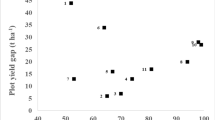Abstract
In both 1981 and 1982, 51 potato fields were surveyed every 7–10 days for early blight severity and fungicide use. Early blight severity data from each field were used as input to a regression model to estimate yield loss in that field. The model for early maturing potato cultivars was Percent Yield Loss=0.8183+0.6441* (% blight increment between days 56 and 66)+0.6102* (% blight increment between days 66 and 76)+1.3480* (% blight increment between days 76 and 86). The model for late maturing cultivars was Percent Yield Loss=2.1846-4.7734* (% blight on day 56)+0.7440* (% blight on day 76)+ 0.5676* (% blight on day 96). In both 1981 and 1982, early blight was found to be present in all fields of the survey. In 1981, early blight was estimated to have caused mean losses of 6.5% (Red River Valley), 3.7% (Central sands) and 2.3% (Southern muck). In 1982, losses from the same areas were 5.4%, 3.7% and 2.6% respectively. In 1981, individual county losses ranged from 2.3% for Freeborn to 12.9% for Marshall while in 1982 losses were from 2.0% for Freeborn to 6.7% for Clay. Although fungicide use data were incomplete, the county with lowest yield loss had the most fungicide applications.
Resumen
Tanto en 1981 como en 1982, se visitaron 51 campos de papa cada 7–10 días para observar la severidad del tizón temprano, y el uso de fungicidas. La información sobre la severidad del tizón temprano en cada campo fue utilizada como datos para un modelo de regresión que permitiera estimar las pérdidas en rendimiento en ese campo. El modelo, para cultivares de papa de maduración temprana fue: Porcentaje de Pérdida en Rendimiento= 0,8183 + 0,6441 (% de incremento del tizón entre los días 56 y 66) + 0,6102 (% de incremento del tizón entre los días 66 y 76)+1,3480 (% de incremento del tizón entre los días 76 y 86). El modelo para cultivares de maduración tardía fue: Porcentaje de Pérdida en Rendimiento=2,1846-4,7734 (% de tizón el día 56)+0,7440 (% de tizón el dia 76)+0.5676 (% de tizón en el día 96). Tanto en 1981 como en 1982, se encontró que el tizón temprano estaba presente en todos los campos estudiados. En 1981, se estimó que el tizón temprano habia causado pérdidas en promedio de 6,5% (Red River Valley), 3,7% (Central sands) y 2,3% (Southern muck). En 1982, las pérdidas en las misma areas fueron 5,4%, 3,7% y 2,6%, respectivamente. En 1981, las pérdidas individuales por distrito variaron de 2,3% para Freeborn a 12,9% para Marshall, mientras que en 1982, las pérdidas fueron de 2,0% para Freeborn a 6,7% para Clay. A pesar de que la información sobre el uso de fungicidas era incompleta, el distrito con la menor pérdida tuvo el mayor numéro de aplicaciones con fungicidas.
Similar content being viewed by others
Literature Cited
Cochran, W.G. 1963. Sampling Techniques. John Wiley & Sons.
Granovsky, A.A. and A.G. Petersen. 1954. Evaluation of potato leaf injury caused by leafhoppers, flea beetles and early blight. J Econ Entom 47:894–903.
Hooker, W.J. (ed.). 1981. Compendium of Potato Diseases. American Phytopathological Society, St. Paul.
James, W.C. 1981. Estimated loss of crops from plant pathogens.In Handbook of Pest Management in Agriculture Vol. 1, pp. 79–93 (ed. D. Pimentel). CRC Press.
James, W.C. and P.S. Teng. 1979. The quantification of production constraints associated with plant diseases. Appl Biol 4:201–267.
Large, E.C. 1952. The interpretation of progress curves for potato blight and other plant diseases. Plant Pathol 1:109–117.
Stakman, E.C. and A.G. Tolaas. 1916. Potato diseases and their control. Minn Agric Exp Stn Bull 158.
Teng, P.S. 1983. Estimating and interpreting disease intensity and loss in commercial fields. Phytopathology 73:1587–1590.
Teng, P.S. and H.L. Bissonnette. 1985. Estimating potato yield responses from chemical control of early blight in Minnesota. Am Potato J 62:595–606.
Teng, P.S. and H.L. Bissonnette. 1985. Developing equations to estimate potato yield loss caused by early blight in Minnesota. Am Potato J 62:607–618.
Teng, P.S. and W.W. Shane. 1984. Crop losses due to plant pathogens. Crit Rev Plant Sci 2:21–47.
U.S. Department of Agriculture. 1965. Losses in Agriculture. Agricultural Handbook no. 291. USDA, ARS.
Waters, L. Jr., P.F. Boldt, J.A. Lofgren, D.M. Noetzel, F.L. Pfleger and H.L. Bissonnette. 1980. Weed, Insect and Disease Control Guide for Commercial Vegetable Growers. Minn Agric Ext Ser Bull 421.
Author information
Authors and Affiliations
Additional information
Paper No. 14,450, Scientific Journal Series, Minnesota Agricultural Experiment Station.
The research in this paper was supported by a grant from the North Central Region Pesticide Impact Assessment Program.
Rights and permissions
About this article
Cite this article
Teng, P.S., Bissonnette, H.L. Potato yield losses due to early blight in Minnesota fields, 1981 and 1982. American Potato Journal 62, 619–627 (1985). https://doi.org/10.1007/BF02854436
Accepted:
Issue Date:
DOI: https://doi.org/10.1007/BF02854436




